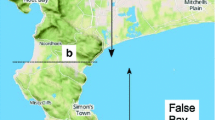Summary
Mesoscale flow characteristics in the Alpine region are deduced from a set of daily large-scale analyses (1981–1990) by means of statistical-dynamical downscaling. This method utilizes the results of a large number of mesoscale numerical simulations in combination with known statistics of the forcing large-scale conditions. The investigation is restricted to cross-Alpine large-scale flow from 165 to 265 degrees at 500 hPa. Such types of flow are favourable to south foehn.
The results provide model-based climatological estimates of surface wind direction and upper-level gravity-wave formation at a horizontal resolution of 20 and 10 km. Simulated surface wind roses agree well with observations and show a dominance of low-level flow around the Alps with bimodal frequency distributions of wind direction north and south of the mountains. The areas where splitted flows preferably merge are identified. Gravity waves are most likely to occur above the western parts of the Alps. A secondary maximum of likelihood was found above Tyrol and Trentino. Surface wind roses and gravity-wave formation are both checked with respect to their sensitivity to season (spring vs. autumn) and large-scale flow direction (south to southwest vs. southwest to west).
Similar content being viewed by others
References
Aebischer, U., Schär, C., 1994: High-resolution simulations of low-level features in the Alpine region.Ann. Meteor.,30, 125–128.
Binder, P. Schär, C. (eds.), 1995: Mesoscale Alpine Programme (MAP)-Design Proposal. Obtainable from Swiss Meteorological Institute, CH-8044 Zürich, Switzerland.
Bretherton, F. P., 1969: Momentum transport by gravity waves.Quart. J. Roy. Meteor. Soc.,95, 213–243.
Chen, W.-D., Smith, R. B., 1987: Blocking and deflection of airflow by the Alps.Mon. Wea. Rev.,115, 2578–2597.
Egger, J., 1995: Regional statistical-dynamical climate modelling: Tests.Beitr. Phys. Atmos.,68, 281–289.
Ekhart, E., 1949: Zum Innsbrucker Föhn.Meteorol. Rdsch.,2, 276–280.
Frey, K., 1984: Der Jahrhundertföhn vom 8. November 1982.Meteorol. Rdsch.,37, 209–220.
Frey-Buness, A., Heimann, D., Sausen, R., 1995: A statisticaldynamical downscaling procedure for global climate simulations.Theor. Appl. Climatol.,50, 117–131.
Fuentes, U., Heimann, D., 1996: Verification of statisticaldynamical downscaling in the Alpine region.Climate Res.,7(2), 151–168.
Giorgi, F., Brodeur, C. S., Bates, G. T., 1994: Regional climate change scenarios over the United States produced with a nested regional climate model.J. Climate,7, 375–399.
Heimann, D., 1986: Estimation of regional surface-layer windfield characteristics using a three-layer mesoscale model.Beitr. Phys. Atmos.,59, 518–537.
Heimann, D., 1990: Three-dimensional modeling of cold fronts approaching the Alps including latent heat effects.Meteorol. Atmos. Phys.,42, 197–219.
Heimann D., 1992a: Three-dimensional modeling of synthetic cold fronts interacting with northern Alpine foehn.Meteorol. Atmos. Phys.,48, 139–163.
Heimann, D., 1992b: Numerical simulation of mesoscale structures in the northern Alpine foreland during front passages: A dry cold front with pre-frontal foehn.Meteor. Zs.,N.F.1, 272–284.
Heimann, D., 1994: REWIH3D-1.0: Physical and technical model description. DLR Institut für Physik der Atmosphäre, Report No. 3, ISSN 0943-4771.
Hoinka, K. P., 1980: Synoptic-scale atmospheric features and foehn.Beitr. Phys. Atmos.,53, 486–508.
Hoinka, K. P., 1985: Observations of the airflow over the Alps during a foehn event.Quart. J. Roy. Meteor. Soc.,111, 199–224.
Hoinka, K. P., Clark, T. L., 1991: Pressure drag and momentum fluxes due to the Alps. I: Comparison between numerical simulations and observations.Quart. J. Roy. Meteorol. Soc.,117, 495–525.
Hoinka, K. P., Rösler, F., 1987: The surface layer on the leeside of the Alps during foehn.Meteorol. Atmos. Phys.,37, 245–258.
Hoinka, K. P., Volkert, H., 1987: The German Front Experiment 1987.Bull. Amer. Meteor. Soc.,68, 1424–1427.
Hoinka, K. P., Hagen, M., Volkert, H., Heimann, D., 1990: On the influence of the Alps on a cold front.Tellus,42A, 140–164.
Jones, R. G., Murphy, J. M., Noguer, M., 1995: Simulation of climate change over Europe using a nested regionalclimate model. I: Assessment of control climate, including sensitivity to location of lateral boundaries.Quart. J. Roy. Meteor. Soc.,121, 1413–1449.
Kohonen, T., 1984: Self-Organization and Associative Memory. Heidelberg: Springer (Series in Information Sciences, 7).
Mahrer, Y., Pielke, R. A., 1977: A numerical study of the airflow over irregular terrain.Beitr. Phys. Atmos.,50, 98–113.
Marinucci, M. R., Giorgi, F., Beniston, M., Wild, M., Tschuck P., Ohmura, A., Bernasconi, A., 1995: High resolution simulations of January and July climate over the western Alpine region with a nested regional modeling system.Theor. Appl. Climatol.,51, 119–138.
Seibert, P., 1990: South foehn studies since the ALPEX experiment.Meteorol. Atmos. Phys.,43, 91–103.
Smith, R. B., 1989: Mountain-induced stagnation points in hydrostatic flow.Tellus,41A, 270–274.
Ungeheuer, H., 1952: Zur Statistik des Föhns im Voralpen gebiet.Berichte des Wetterdienstes in der U S-Zone,38, 117–120.
Wippermann, F., Gross, G., 1981: On the construction of orographically influenced wind roses for given distributions of the large-scale wind.Beitr. Phys. Atmos.,54, 492–501.
Wippermann, F., 1984: Air flow over and in broad valleys: channeling and counter-current.Beitr. Phys. Atmos.,57, 92–105.
Zorita, E., Hughes, J. P., Lettemaier, D. P., von Storch, H., 1995: Stochastic characterization of regional circulation patterns for climate model diagnosis and estimation of local precipitation.J. Climate,8, 1023–1042.
Author information
Authors and Affiliations
Additional information
With 13 Figures
Rights and permissions
About this article
Cite this article
Heimann, D. Mesoscale surface-wind characteristics and potential gravity-wave formation during cross-Alpine airflow. Meteorl. Atmos. Phys. 62, 49–70 (1997). https://doi.org/10.1007/BF01037479
Received:
Revised:
Issue Date:
DOI: https://doi.org/10.1007/BF01037479




